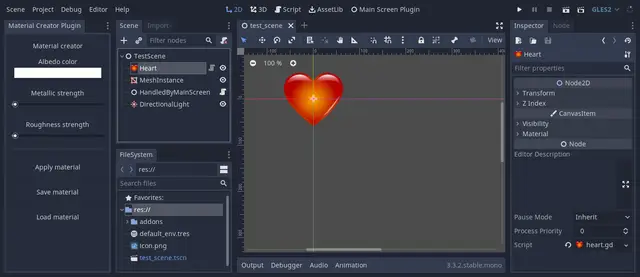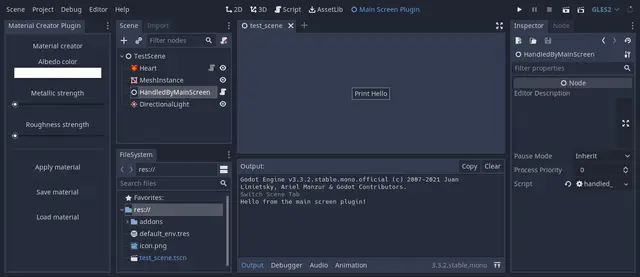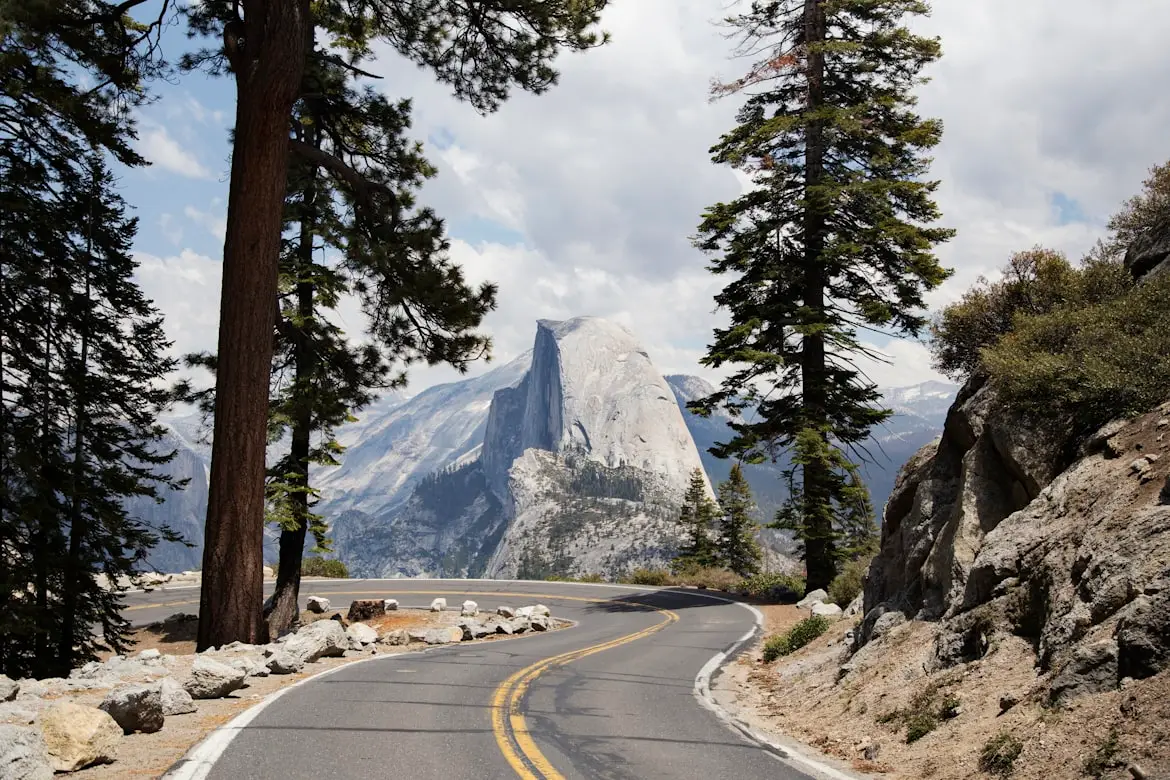Install Asset
Install via Godot
To maintain one source of truth, Godot Asset Library is just a mirror of the old asset library so you can download directly on Godot via the integrated asset library browser




Quick Information

This contains multiple plugin demos, all placed in a project for convenience.Due to GitHub issue #36713, you need to open the project to import the assets once, then close, then open: https://github.com/godotengine/godot/issues/36713See the documentation on editor plugins for more information: https://docs.godotengine.org/en/latest/tutorials/plugins/editor/index.htmlHow it works:This project contains 4 plugins:- The custom node plugin shows how to create a custom node type using `add_custom_type()`.- The material import plugin shows how to make a plugin handle importing a custom file type (`*.mtxt`). - The material creator plugin shows how to add a custom dock with some simple functionality. - The main screen plugin is a minimal example of how to create a plugin with a main screen.Check the `README.md` files included in each plugin's folder for more information.To use these plugins in another project, copy any of these folders to the `addons/` folder in a Godot project, and then enable them in the project settings menu.For example, the path would look like: `addons/custom_node/`Plugins can be distributed and installed from the UI. If you make a ZIP archive that contains the folder, Godot will recognize it as a plugin and will allow you to install it.This can be done via the terminal: `zip -r custom_node.zip custom_node/*`Language: GDScriptRenderer: Compatibility
Plugin Demos
This contains multiple plugin demos, all placed in a project for convenience.
Due to issue #36713, you need to open the project to import the assets once, then close, then open.
See the documentation on editor plugins for more information.
Language: GDScript
Renderer: Compatibility
Check out this demo on the asset library: https://godotengine.org/asset-library/asset/585
How does it work?
This project contains 4 plugins:
The custom node plugin shows how to create a custom node type using
add_custom_type. More info.The material import plugin shows how to make a plugin handle importing a custom file type (mtxt). More info.
The material creator plugin shows how to add a custom dock with some simple functionality. More info.
The main screen plugin is a minimal example of how to create a plugin with a main screen. More info.
To use these plugins in another project, copy any of these
folders to the addons/ folder in a Godot project, and then
enable them in the project settings menu.
For example, the path would look like: addons/custom_node
Plugins can be distributed and installed from the UI. If you make a ZIP archive that contains the folder, Godot will recognize it as a plugin and will allow you to install it.
This can be done via the terminal: zip -r custom_node.zip custom_node/*
Screenshots





This contains multiple plugin demos, all placed in a project for convenience.
Due to GitHub issue #36713, you need to open the project to import the assets once, then close, then open: https://github.com/godotengine/godot/issues/36713
See the documentation on editor plugins for more information: https://docs.godotengine.org/en/latest/tutorials/plugins/editor/index.html
How it works:
This project contains 4 plugins:
- The custom node plugin shows how to create a custom node type using `add_custom_type()`.
- The material import plugin shows how to make a plugin handle importing a custom file type (`*.mtxt`).
- The material creator plugin shows how to add a custom dock with some simple functionality.
- The main screen plugin is a minimal example of how to create a plugin with a main screen.
Check the `README.md` files included in each plugin's folder for more information.
To use these plugins in another project, copy any of these folders to the `addons/` folder in a Godot project, and then enable them in the project settings menu.
For example, the path would look like: `addons/custom_node/`
Plugins can be distributed and installed from the UI. If you make a ZIP archive that contains the folder, Godot will recognize it as a plugin and will allow you to install it.
This can be done via the terminal: `zip -r custom_node.zip custom_node/*`
Language: GDScript
Renderer: Compatibility
Reviews
Quick Information

This contains multiple plugin demos, all placed in a project for convenience.Due to GitHub issue #36713, you need to open the project to import the assets once, then close, then open: https://github.com/godotengine/godot/issues/36713See the documentation on editor plugins for more information: https://docs.godotengine.org/en/latest/tutorials/plugins/editor/index.htmlHow it works:This project contains 4 plugins:- The custom node plugin shows how to create a custom node type using `add_custom_type()`.- The material import plugin shows how to make a plugin handle importing a custom file type (`*.mtxt`). - The material creator plugin shows how to add a custom dock with some simple functionality. - The main screen plugin is a minimal example of how to create a plugin with a main screen.Check the `README.md` files included in each plugin's folder for more information.To use these plugins in another project, copy any of these folders to the `addons/` folder in a Godot project, and then enable them in the project settings menu.For example, the path would look like: `addons/custom_node/`Plugins can be distributed and installed from the UI. If you make a ZIP archive that contains the folder, Godot will recognize it as a plugin and will allow you to install it.This can be done via the terminal: `zip -r custom_node.zip custom_node/*`Language: GDScriptRenderer: Compatibility
